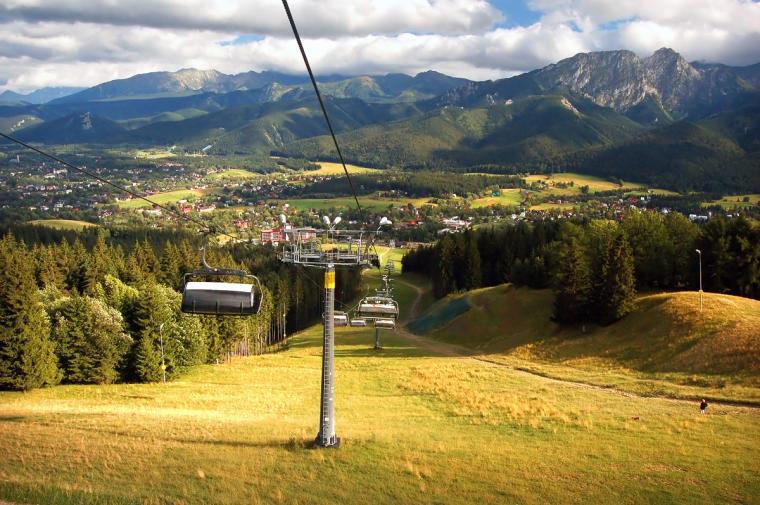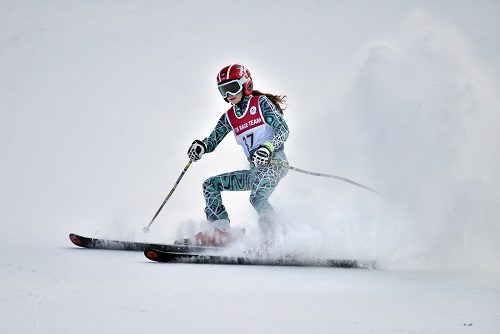
Photo © Michal Bednarek | Dreamstime.com
The season’s first Snowboard Cross World Cup and Ski Cross World Cup competitions had to be called off because of a lack of snow in Les Deux Alpes, the French resort that was to host them. It’s far from the first event to ever be adversely affected this way; in fact, competitions as high up the food chain as the Olympics, and as grassroots as recreational skiing at local areas have been impacted.
What’s curious, though, is the fact that organizations increasingly are signing onto sustainability initiatives in the hopes of combatting climate change.
The 2023 International University Sports Federation (FISU) World University Games in Lake Placid, for example, are expected to set a new standard for the event in terms of environmental sustainability as part of a Save Winter initiative.
According to Inside The Games, the initiative is pledging climate action through educating visitors, reducing and mitigating the event’s carbon footprint, minimizing waste that goes to the landfill, encouraging responsible sourcing of all goods and services used, and leaving behind a legacy of awareness for future sporting events in the Adirondack region, New York State and beyond.
"Everyone who lives, plays and works in a winter community knows that our climate is warming and we’re going to lose winter if we don’t do something," said Ashley Walden, executive director of the Adirondack Sports Council, the Lake Placid 2023 FISU World University Games Organizing Committee.
The Save Winter project will be the theme for both the FISU World Conference and sustainability initiatives at the FISU Games, powered by Hydro-Quebec and supported by ESPN, Karbon, and Microplus. And competitions will be held throughout the season at winter sports events, highlighting destinations that have shown a commitment to sustainability and combating climate change impacts to winter activities.
Governing bodies are also taking a proactive approach. The Association of National Olympic Committees (ANOC) met the XXVI ANOC General Assembly in Seoul and discussed sustainability in sports.
All the way back in 2020 (just prior to the onset of the pandemic), the issue was being studied. “If greenhouse gas emissions continue at the same level, snow will almost disappear at lower levels by the end of the century,” Marc Olefs, head of the department for climate research at Vienna’s Central Institute for Meteorology and Geodynamics, told Bloomberg.com in an article headlined “Climate Change Is Killing Alpine Skiing as We Know It.” He predicted that even producing artificial snow will become more difficult because of rising temperatures.

In Garmisch-Partenkirchen, Germany — site of the 1936 Winter Olympics —year-round tourism is big business, with summer visitors generating more economic impact than winter these days. That’s a trend local businesses might have to get used to, as the winters become shorter.
“We have to come up with concepts to maintain the winter tourism that we still have,” Garmisch Mayor Sigrid Meierhofer told Bloomberg.com. “You say it’s brown — I say the hiking paths are open.”
Inside The Games also notes, [In 2020], “he seventh leg of the International Ski Federation (FIS) Nordic Combined World Cup in Otepää in Estonia was cancelled due to continuing high temperatures in the country leading to no snowfall. The resort was also scheduled to host two FIS Continental Cup jumps, but they too were cancelled.”
In March of 2019, citing research published in the journal Geophysical Research Letters, CNBC.com reported that snowfall amounts in the western United States had declined an average of 41 percent since the early 1980s. As a result, the snow season has shrunk by 34 days.
The weather was also wreaking havoc on more than just tourism. According to researchers at the University of Wisconsin, home values near ski resorts could drop by at least 15 percent by 2050 due to warmer winters. At lower-elevation ski areas, such as in Utah, Idaho, Nevada and parts of California, they could fall as much as an estimated 55 percent.
In an effort to drive climate policy and the clean energy economy for the $887 billion outdoor business sector, Snowsports Industries America, the Outdoor Industry Association and the National Ski Areas Association last year collectively launched the Outdoor Business Climate Partnership. The OBCP represents thousands of outdoor retailers, manufacturers, suppliers, sales reps and resorts across the country and seeks bipartisan action on climate change.
The problems stretch back – and they’re not getting easier. The Sochi 2014 Winter Olympics needed a snow boost, as did the Vancouver Olympics in 2010 four years prior.
Throughout the years, many events and destinations have coped with a lack of snow in varying, and often creative, ways. These included shuttling snow from place to place via train, truck or any method available. It has even become a niche market for those with the wherewithal to deal with it.
“The need is obvious,” Finnish snow-storage pioneer Mikko Martikainen, 59, told reporters at Outside Magazine in 2016. Martikainen led a four-year effort to store one million cubic meters of snow for the Sochi Olympics. “Look at resorts in Europe this winter: very [low snowfall]. And scientists are estimating no skiing below [6,500 feet in elevation] in the Alps in 20 years. But if you store snow, your business won’t be ruined.”
After seeing snow in summer (and noticing it hadn’t melted because it was insulated by a pile of debris), Martikainen had his a-ha moment. He started his snow-storage business, Snow Secure, in 2005. Today, he travels around the world, working with more than 20 ski areas and consulting with international ski federations from Norway to Croatia. He even flew to South Korea to conduct tests with the organizing committee for the 2018 Winter Games in order to ensure there would be enough snow to stage the alpine and cross-country competitions.
Harvesting snow is a process, but storing it, the article notes, is a science. The most common method involves covering piles of natural and manmade snow or crucial pieces of a glacier with a polypropylene tarp with reflective properties at the end of the spring. If done correctly, it can preserve the snow until the following fall. In some cases, more sophisticated measures are used, depending upon the amount of snow needed and the speed at which it must be moved.
Of course, the question often becomes: why not just use a snow-making system, like those found at ski resorts?
Because, as it turns out, it’s just not that simple. According to an article in Bloomburg Business, snowmaking is an incredibly expensive, complex process.
Equipment to make enough snow to fully coat a large area can’t be rented or borrowed, and the massive amount of water needed to create so much snow demands infrastructure that must be designed into the resort.
In short, no matter how important your event is, you can’t just set something up, turn it on and start making snow.
The issue of climate change also causes a constant reconfiguration of snowmaking plans. If winters continue to get warmer, as they’re predicted to do, resorts will need an increasing amount of water, as well as an increasing amount of snowmaking guns, and will need to blow them more and more often.
“At 20 degrees, it’s easy and takes relatively low power and relatively little water,” Jordy Hendrikx, director of Montana State University’s Snow and Avalanche Laboratory, told Bloomberg. “At 32, it takes huge amounts of both to make low-quality snow, and there isn’t a lot of it.” The power required for snowmaking exacerbates climate change and causes temperatures to rise, which in turn requires more snowmaking.
In California, ski resort Heavenly Valley keeps its tourism industry going with its sophisticated equipment – but it comes at a cost. There are smartphone-controlled snowmaking systems made up of fiber-optic cables and low-energy fan guns that can cost upwards of $40,000 each, and even with that, a dedicated crew is constantly measuring and monitoring conditions.
Smaller, less moneyed venues don’t have that level of adaptability. For example, little Sierra-at-Tahoe, less than 20 miles from Heavenly, has six older snowmaking guns that it occasionally runs at low levels, but managers understand the resort cannot afford the amount of water it would take to use equipment like that found at Heavenly.
Instead, the crew at Sierra does its own form of snow storage, collecting snow from the deck of the day lodge and from its parking lots, then hauling it up the slopes. Snow fences, usually erected next to blustery highways in Wyoming, catch any extra snow that blows in. This too is transported up the hill.
It’s a day-to-day method of survival that is common to resorts without sophisticated snowmaking equipment.
“A small player may only weather one bad season and cash reserves will be gone,” Daniel Scott, a professor of tourism management at the University of Waterloo in Canada who has studied the effects of climate change on the ski industry, told Bloomberg. “Two bad seasons, and that’s all she wrote.” As it is, only 45 American ski areas have climbing revenues, and this 10 percent of hills already accounts for 40 percent of all ski business, according to former Vail Resorts and Intrawest exec Bill Jensen. Within a decade, it is theorized that 300 of the 470 U.S. ski resorts could be gone.
And that, say activists, is why they are getting busy now. Initiatives and organizations devoted to sustainability and eco-friendly practices in sports include the following:


